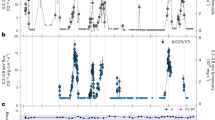Abstract
DISCRETE astronomical sources of photons in the TeV energy range are believed to be associated with regions in the relativistic outflow of particles and radiation from compact objects, such as neutron stars and black holes. The flux from such sources, together with the timescales on which they vary, can provide strong constraints on the emission mechanisms. Here we report the observation of two dramatic outbursts of TeV photons from the active galaxy Markarian 421 (Mrk421). In the first outburst, which had a doubling time of about one hour, the flux increased above the relatively quiescent value by more than a factor of 50, briefly making Mrk421 the brightest TeV source in the sky. In the second outburst, which lasted approximately 30 minutes, the flux increased by a factor of 20–25. These data suggest that the emission region is extremely small—perhaps even smaller than our Solar System. This could prove challenging for current theoretical models of such emissions.
Similar content being viewed by others
References
Punch, M. et al. Nature 358, 477–478 (1992).
Cawley, M. F. & Weekes, T. C. Exp. Astron. 6, 7–42 (1995).
Reynolds, P. T. et al. Astrophys. J. 404, 206–218 (1993).
Fegan, D. et al. in Towards an Atmospheric Cherenkov Detector Vol. III (ed. Kifune, T.) 149–162 (Universal Academy Press, Tokyo, 1994).
Weekes, T. C. et al. AIP Conf. Proc. 304, 270–274 (1993).
Schubnell, M. S. et al. Astrophys. J. 460, 644–650 (1996).
Macomb, D. J. et al. Astrophys. J. 449, L99–L103 (1995).
Kerrick, A. D. et al. Astrophys. J. 438, L59–L62 (1995).
Buckley, J. H. et al. Astrophys. J. (in the press).
Blandford, R. D. & Rees, M. J. In Proc. Pittsburgh Conference on BL Lac Objects (ed. Wolfe, A. N.) 328–347 (Univ. Pittsburgh Press, 1978).
Dermer, C. D. & Schlickeiser, R. Astrophys. J. 416, 458–484 (1993).
Sikora, M., Begelman, M. C. & Rees, M. J. Astrophys. J. 421, 153–162 (1994).
Königl, A. Astrophys. J. 243, 700–709 (1981).
Blandford, R. D. & Königl, A. Astrophys. J. 232, 34–48 (1979).
Mattox, J. R. et al. Astrophys. J. 410, 609–614 (1993).
Inoue, S. & Takahara, F. Astrophys. J. 463, 555–564 (1996).
Begelman, M. C., Rees, M. J. & Sikora, M. Astrophys. J. 429, L57–L60 (1994).
Kniffen, D. A. et al. Astrophys. J. 411, 133–136 (1993).
Author information
Authors and Affiliations
Rights and permissions
About this article
Cite this article
Gaidos, J., Akerlof, C., Biller, S. et al. Extremely rapid bursts of TeV photons from the active galaxy Markarian 421. Nature 383, 319–320 (1996). https://doi.org/10.1038/383319a0
Received:
Accepted:
Issue Date:
DOI: https://doi.org/10.1038/383319a0
- Springer Nature Limited
This article is cited by
-
Study of the Rapid Variability of the BL Lac Object MRK 421 in the Optical Range
Astrophysics (2022)
-
Gamma-ray emitting narrow-line Seyfert 1 galaxies: Past, present, and future
Journal of Astrophysics and Astronomy (2019)
-
The radio and γ $\gamma$ -ray variability analysis of S5 0716+714
Astrophysics and Space Science (2018)
-
Optical variability of Mrk 421
Astrophysics and Space Science (2014)
-
Active galactic nuclei — the physics of individual sources and the cosmic history of formation and evolution
Frontiers of Physics (2013)





